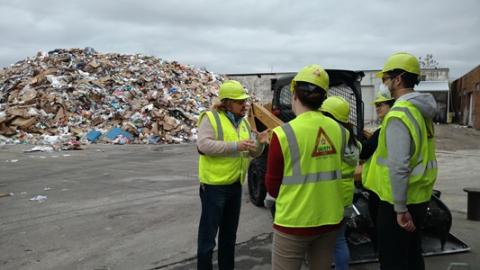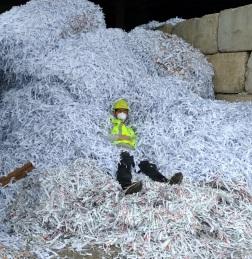Visiting the MRF
Walking into the Materials Recovery Facility (MRF) in Baton Rouge, La, I saw two large mountains of material reaching almost three stories high...

Amazed at its size, I couldn’t help but think of the amount of waste produced in the world. If these mountains are from the surrounding area of one city on any given day, then there must be exponentially more produced daily throughout the United States.
The most common form of waste disposal is burying material in a landfill. A draw back about burying material is that there is a limited amount of surface area on the planet. Eventually, there will not be any space available. In addition to the lack of space, the materials we are filling holes with are valuable resources! For example, as much as 50% of all landfill space is taken up by paper, much of which could have been recycled. Had all that paper been recycled, more energy and resources (like trees and water) could have been saved (source). There needs to be another option, and the MRF is part of the solution to this problem.

The purpose of a MRF is to sort single stream recycling – recycling collection like we have on campus where multiple types of recyclable material are collected together— into like types of material. The MRF uses impressive technology to sort through the mountains of material it receives. A combination of hand sorting, conveyor belts, magnets, air compression machines, and others are used to sort material into its appropriate containers. The like material (broken glass, paper, aluminum, and plastics) is then bundled and bailed and sold to their respective manufacturing facilities to be recycled back into raw forms to be used again. The MRF provides a valuable service to the community by extending the life of raw materials and preserving the environment.
Below are a few little-known tips that individuals should use when recycling so that the MRF can most efficiently and effectively process the material it receives:
- First, when in doubt, throw it out. If you don’t know if something can be recycled, then it is better to send it to the landfill rather than have it mixed in with recyclable materials. Having the wrong material mixed in with recyclables can slow down the sorting process or damage machinery.
- Don’t ever recycle plastic bags or film in a single-stream bin. This includes bagging recyclables before putting them in a bin. It is best to empty clean, dry recyclables directly into a recycling bin, cart, or dumpster because bags get caught up in the machinery. Other “tanglers” like chords and wires get caught up in the machinery as well, so those should also never be placed in a single-stream recycling bin.
- Keep paper flat rather than crumbling it up. Keeping paper flat allows the machinery to properly sort out the paper from the other material. When crushed into a ball it does not get recognized as paper and can contaminate another stream of material. (Note: If paper is shredded, this does need to be bagged in order to get recycled at the MRF – the only time a plastic bag should go in a recycling bin!)
And of course, food or liquids of any kind should never go in a recycling bin!
Recycling allows us to conserve our resources, and we want to conserve as much as we can. So let’s follow the suggestions given to get the “most bang for our buck”.
If you’re interested in learning more how to recycling, check out https://recyclingsimplified.com/.
Written by: Joseph Nelson, Zero Waste Graduate Assistant

